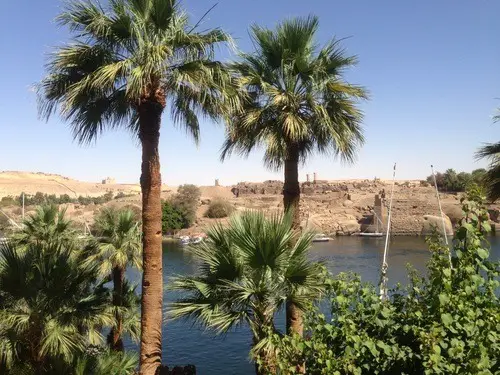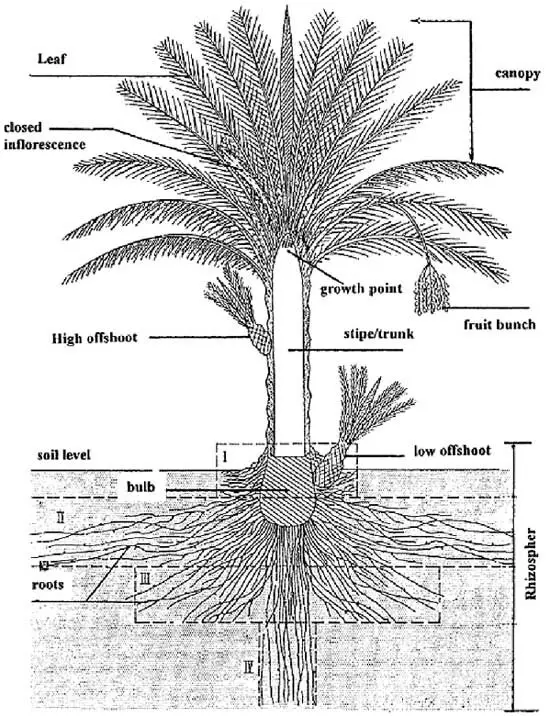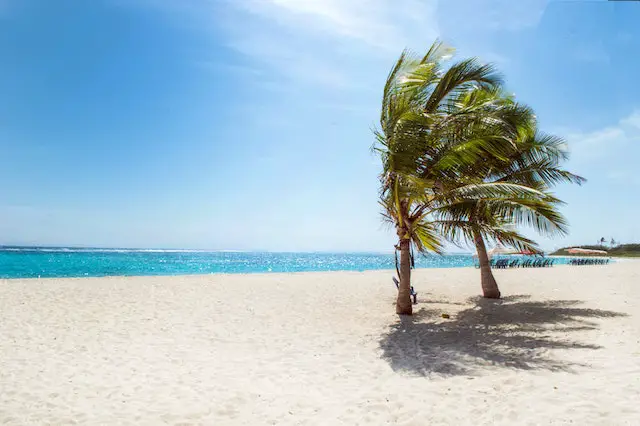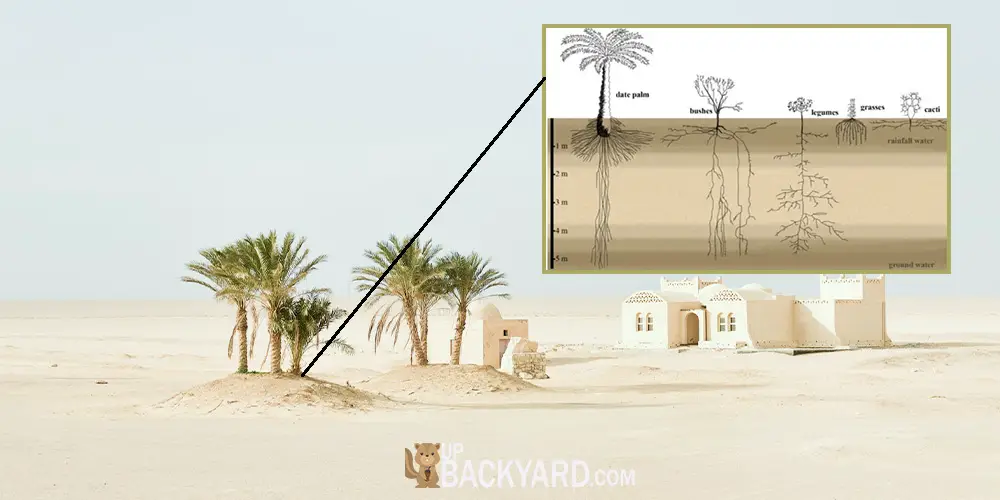Deserts seem like the sort of place where nothing could survive. With extreme heat indexes and months of no rain, it seems counter intuitive that palm trees would be able to thrive, but you find them standing tall for decades against the sun and the sand. How do palm trees survive in the desert?
Palm trees have adapted to the desert environment which allows them to thrive in otherwise inhospitable conditions.
They have wide root systems that help soak up every inch of water and thick trunks that can store it for months.
They also have the ability to reabsorb water that has been placed into their coconuts and fronds that don’t burn in the sun no matter how hot it is.
How Do Palm Trees Survive In The Desert?
Surviving in the desert is no easy feat, but palm trees make it look effortless.
Thanks to their many adaptations, they are able to not only survive, but thrive in an environment that offers them next to nothing.
Read on to discover the amazing things that palm trees can do to survive in the desert.
Thick Trunks
Thanks to their thick and fibrous trunks, palm trees can store a lot of water. When there is rainfall, they can quickly and efficiently drink up enough water that they will then store within their trunk.
This practice allows palm trees to survive long periods of time with no rainfall. Since the trunk of the palm tree is so thick, no water will be lost to evaporation.
However, even with this unique and life-saving adaptation, palm trees still desperately need water. Oftentimes, they will be found growing near a water source, even in the height of deserts.

Many times, oases are pictured in books or movies as lakes and luscious palm trees in the middle of a desert.
This image is very true to how you would find palm trees in the desert in real life. The water system helps the palm tree thrive and survive.
Wide Root Networks
It might seem silly that a palm tree would grow near a water source if it could not actually reach and benefit from it. Palm trees have massive and wide root networks that help it search a large range of land for water.
This also helps the plant gather water quickly when a rainfall does happen. Since their roots are spread widely throughout a region, they will be able to efficiently soak up as much water as possible to store in their trunks.

Their wide root network also helps anchor the plant into the earth. This way they can withstand strong winds and storms.
Water Reabsorption
Many palm trees produce fruit, like coconuts. During times of drought or severe water shortages, palm trees will actually reabsorb the water that has been placed in the coconuts to sustain themselves!
If you have ever cracked open a coconut, you will know that these fruits are often filled to the brim with delicious coconut water, making these brown and green sacks the perfect pick me up for a thirsty palm tree.
Sunlight Tolerance
The hot desert sun does not spare anyone or anything that crosses its path. Many plants will burn or suffer if placed in direct sunlight for long periods of time. Palm trees have a sun tolerance that other plants do not.
Even after days of direct sunlight beating down on them, the fronds of the palm tree will not be affected. They don’t burn or become harmed from the sun’s strong rays.
Wind Tolerance

Thanks to their wide root system and flexible trunks, palm trees are great at withstanding strong winds and storms. The root system helps anchor them into the earth while their flexible trunks move with the wind, preventing breakage or damage!
Desert storms are common and without anything to break the wind, the wind speeds can get very high. Palm trees are well-equipped to ride out any storm with minimal or no damage at all!
Where Do Palm Trees Naturally Grow?
Palm trees are almost always pictured when someone is thinking of a tropical oasis. They grow in many places throughout the world and there are species native to almost every country!
Some palms grow in rainforests in South America while others grow in the humid heat of Louisiana or Florida. Others grow in the deserts of Saudi Arabia or in the southern parts of India.
Since palm trees and palm varieties are so common throughout the world, almost everyone has seen or come in contact with them. Each species has their own unique features and adaptations that help them survive and thrive in different places and environments.
Can I Grow Palms In My Backyard?
Many places are conducive to growing palm trees outdoors. You will need to ensure that your area has the climate that palm trees can survive in. They do not like cold weather and will not survive a hard frost.
Many places in the southern parts of the United States can easily and successfully grow palm trees. Places like Nevada, California, New Mexico, Florida, Texas, Louisiana, and even Georgia all provide the right climate for growing palm trees.
Be sure to choose a palm tree variety that is native to your area. You also want to check out the mature size of the plant. Palm trees can grow extremely tall and live for decades!
Can I Grow Palm Trees Indoors?
If you do not live in an area that has the type of temperature and climate a palm tree needs to survive, there are many options of palm species that can be grown in pots right inside your home!
Since most people keep their homes warmer than 60°F, smaller and dwarf varieties of palms can be kept as houseplants with proper care.
You may want to invest in a humidifier to provide your palm plant with enough air moisture since they are used to tropical climates.
Again, be sure to check into the size and lifespan of your palm plant. Even though it says dwarf doesn’t mean that the plant will not get larger than you want for your house!
Can I Grow a Palm Tree in a Pot?
Growing palm trees in pots is a great way to bring these unique and beautiful plants into your home or your patio space.
Palms in pots cannot grow as quickly as palms planted in the ground, so pots offer a way to control the speed at which your palm tree grows.
Another perk of growing your palm in a pot is that you can move them around. If you live in an area that gets too cold to grow palms outdoors, you can move the pot inside when the weather begins to chill but enjoy the palm on your patio during the warm summer months.
Not all Palm varieties will do well in pots, so be sure to check out your local nursery and speak with a professional. They will be able to answer any questions you may have about growing and caring for potted palms.
Final Thoughts
Palm trees are a marvel of nature. They grow in many places throughout the world and can survive some of the harshest climates. These plants grow in places with warm and oftentimes humid climates. You will find palms in places that are covered in rainforests as well as deserts.
Since all plants need water to survive, palm trees have adapted to the dry and drought filled desert areas thanks to their unique root systems and thick trunks.
They have root systems that spread out wide instead of down, to easily access any drop of water that hits the surface of the sand. Then, the water travels to their thick trunks which are hollow inside to store large amounts of water.
Palm trees can go weeks without water due to their storage! They also can reabsorb any water that they used to create their coconuts which can be helpful in times of severe drought.
Their coconuts aren’t the only thing that palm trees have that help them survive the desert heat, their fronds do not get sunburned no matter how much direct sunlight they get!
Palm trees are beautiful and resilient plants, and some people want to grow them in their own backyards. Luckily, if they live in a hot enough climate, they can!
If you do not live in an area that is conducive to palm tree growth, you can grow smaller varieties in pots indoors!
This provides the beauty and tropical vibe of a palm without having to worry about the climate outdoors. Be sure to grab a dwarf or even parlor variety of palm to avoid it growing too large and overtaking your space.
Now that you know how palm trees survive in a desert, you can apply that knowledge to taking care of your own palm tree! Be sure not to over-water it and provide it with plenty of bright sunshine.
